by B.B. Pelletier
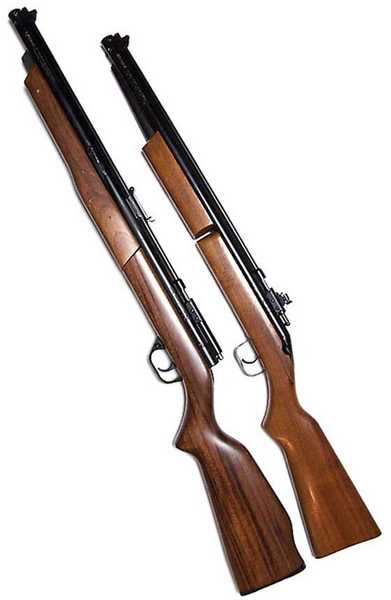
The Benjamin 397 (left) is a powerful multi-pump. Obsolete 397 carbine at right.
Today, we have a critical report about airgun maintenance and operation. So, if we’re being critical, let’s start with the title. It’s a It’s no one’s fault — let’s all get along title. It should read, Oops! I really screwed up! And when I say “I,” that’s exactly what I mean!
About a month ago, a friend of mine — who shall remain nameless, unless he repeates what I am about to tell you — received a new Benjamin 397 multi-pump pneumatic. Hurray!
I went over all the operational and maintenance steps carefully with him — pump it no more than 10 times per shot, always store it with one pump in it, use Pellgunoil on the pump head etc. — and then turned him loose with his new rifle. Last week the rifle came back to me with the complaint that it didn’t fire pellets anymore.
I must have looked like that old plumber who knows just where to tap the pipe to get the system going again, because before I even examined the rifle I told him it was over-pumped and therefore valve-locked. Then, I took the rifle and opened the pump handle, which sprang open with a lot of force. Yep — it’s valve-locked, all right!
I listened carefully to the story of how it couldn’t possibly have been anything that he did wrong. I’ve heard that same story a hundred times before; but like a compassionate priest, you have to let them confess everything as you listen in silence. On about the third go-round, I got the real story.
It seems he was at work, shooting his new gun with a buddy who was also shooting his own multi-pump. Remember, folks, we’re talking Texas, here. Depending on your job, shooting at work isn’t that uncommon. Perhaps not at a funeral home or at a fast-food franchise, but there are a lot of outdoor jobs where shooting is possible and not objectionable.
They were shooting at a metal sign that the buddy’s gun wasn’t able to dent very much, but the 397 put a big ole’ dent in it. However, something wasn’t right! It seems the other guy’s pump gun was much easier to pump than the 397. What was wrong with the 397?
What was wrong with it was that it wasn’t a Crosman 760, like the other guy’s gun! At least that’s my guess. I’m still waiting to hear what the other guy’s gun was.
So, his new gun was harder to pump, but it was also a lot more powerful. MAYBE he wanted to see if the 397 would go all the way through the sign, thus vexing his friend, which is the tradition whenever two guys shoot together. He pumped it ALL the way up, being VERY CAREFUL not to exceed the 10-pump limit, as I’d instructed him. But that time it fired only weakly.
He handed his rifle to his friend, who then pumped it up again, also being VERY CAREFUL not to exceed the 10-pump limit, because the owner was watching him. This time when the trigger was pulled, the gun just went CLICK and no pellet came out. So, now he knows that his gun doesn’t work anymore.
At least he stopped when it got to this point. He didn’t keep loading pellets and pumping it a couple more times just to be sure. I have seen owners do that before.
He brought me the rifle and asked if I could possibly help him. I told him there are two ways to go about this. One is to wait a couple months and hope that the gun leaks down enough that the valve is no longer locked. If the gun had not been properly oiled with Crosman Pellgunoil, that might have been a possible solution. But it was well-oiled, and I didn’t think it would leak down in even a year!
I decided to go the other way. I would remove the extra air mechanically by partially disassembling the gun and rapping on the valve stem with a heavier hammer. That’s how the repair center fixes guns that are over-pumped. Or, at least it used to be! This is where the “old plumber” became a student, again.
I discovered that the new 397’s design is vastly different from what I was used to. You can no longer do what I just said because the gun is not designed to allow it. The new design is much cheaper to build and easier to repair — except when the gun is over-pumped. I’ll describe what I did and what happened as a result — and I don’t see any other way of doing the job.
Poor photos today
I apologize for the poor photos that follow. I was working on the gun and getting dirty, so I used the flash on the camera to make the work go faster. That’s why everything is so over-exposed.
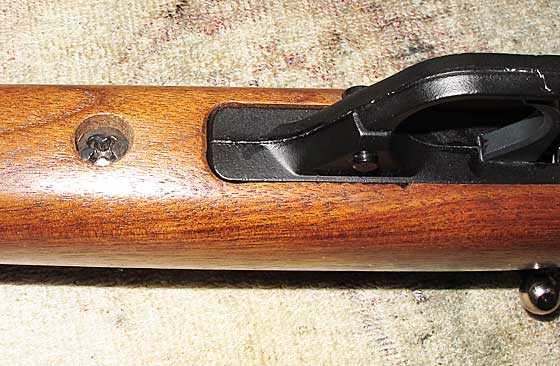
What appears to be the stock screw also holds the valve inside the pressure tube. If the rifle is pressurized, this screw will be under pressure from the valve body trying to move! If this is the case, remove the bolt before you loosen this screw!
The new 397 valve is held in the gun by the single stock screw. That screw fastens the trigger group to the action, and there’s no way to rap out the air the way I described it earlier. I did an internet search and discovered there were no instructions on what to do! In fact, everyone dances around this design almost as though they don’t understand it, though I’m quite sure most of them do. It’s so much simpler than the guns I’m used to. When a gun is over-pumped, there seems to be no good way of depressurizing it — other than to remove the single screw I just described and let the air blow out. But before you do, be sure to remove the bolt first!
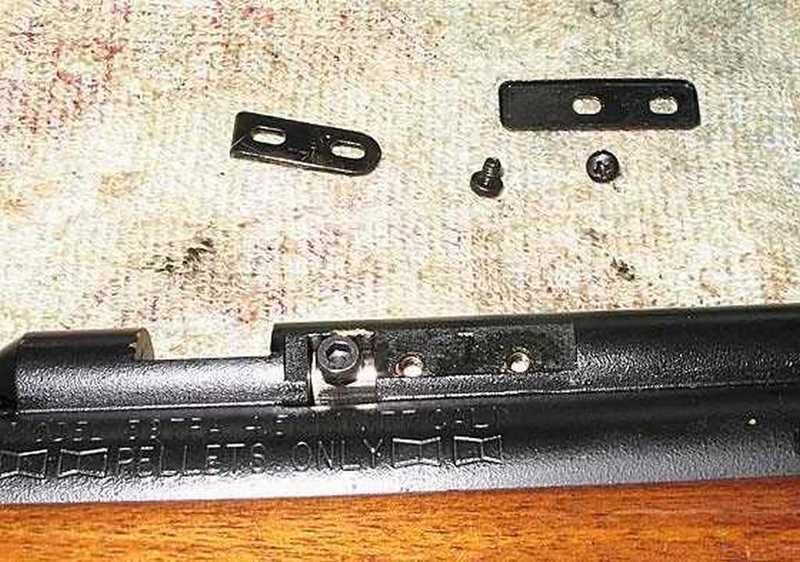
Remove the two sideplate screws and the sideplate and cocking plate will come off (right and left, respectively in this photo). Then, you can remove the Allen screw from the bolt.
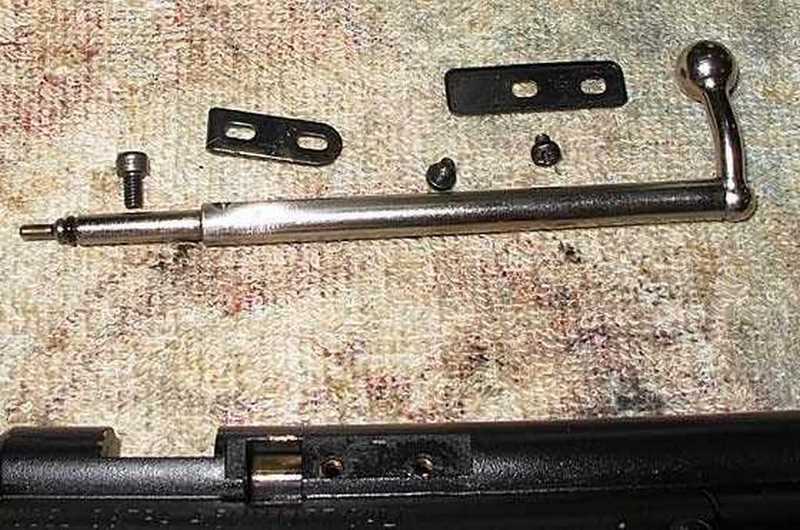
Once the Allen screw is out, the bolt slides out of the receiver.
I didn’t know it while I was doing it, of course, but when the stock screw backed out sufficiently far, the air exploded out of the gun as the valve moved within the pressure tube. It caught me by surprise, but in retrospect I can’t see a better way of doing the job. If anyone knows of one, I’d like to hear what it is.
In retrospect, I should have removed the bolt from the gun before removing the stock bolt. To do that, remove the two screws that hold the sideplate to the left side of the action, exposing the Allen screw on the bolt that cocks the hammer. Then remove the Allen screw, and the bolt slides out of the action.
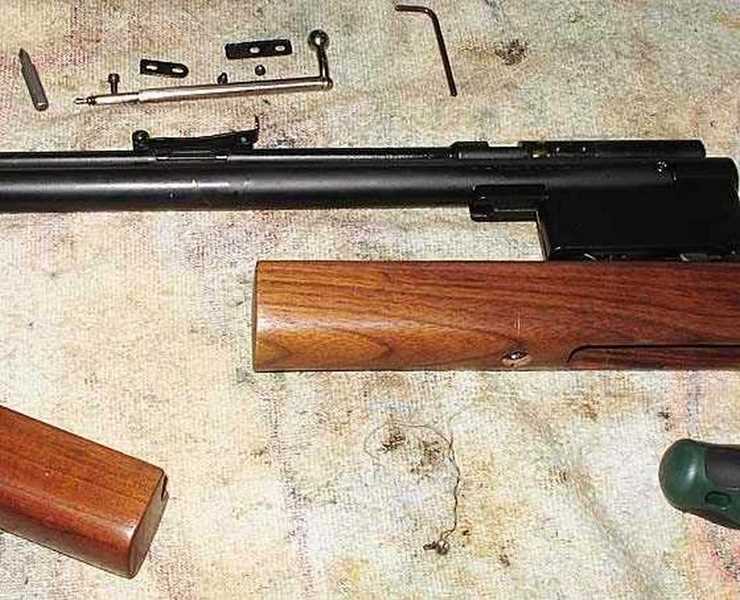
The action can be removed from the stock when the one Phillips screw is loose. The screw is captive inside the stock and doesn’t show here.
At this point, I finished the disassembly, checked all the parts to see that they were okay, which they were, and assembled the gun again. There’s a trick to assembling this gun. The pump arm must be swung forward to allow the valve to go forward enough for access to the screw hole. If you do that, this is an easy pneumatic to assemble. If you don’t — good luck!
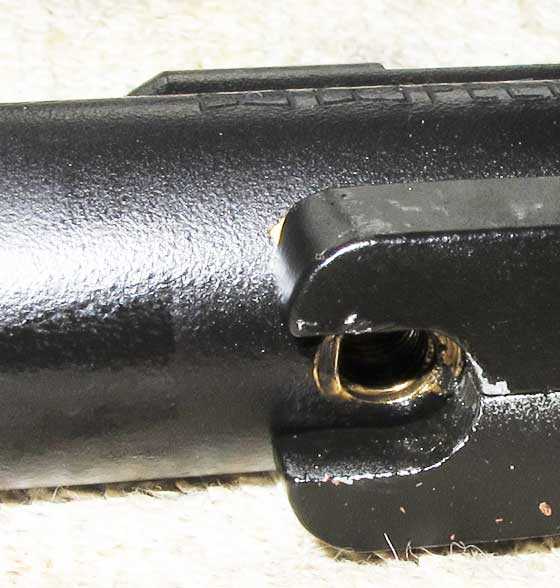
You’re looking through the screw slot in the triggerguard at the brass valve body and its fastening screw hole. How many people would realize that their one stock screw is holding all this?
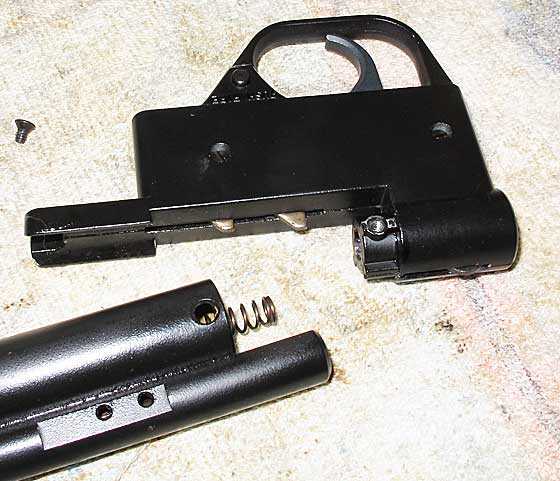
This picture shows why you cannot just rap out the air anymore. The rear of the pressure tube is blocked by the back of the trigger assembly, which has to be removed to gain access to the valve.
And how does it work?
The rifle now works fine, but I’ll run a little test to see how fine. I’ll shoot the gun through a chronograph on six pumps, and keep increasing the number of pumps until there air remains in the gun after the shot. Then, I can tell the owner what the exact maximum safe number of pumps are for this specific gun. That’s another great reason for owning a chronograph!
Checking the velocity
I decided to use Crosman Premiers in the 7.9-grain weight for my test pellets. This is what the gun now does.
Pumps…Velocity…Air remaining?
6………….613………..No
7………….650………..No
8………….688………..Yes! A soft pop was heard.
9………….713………..Yes — a second shot went 555 f.p.s.
Chronograph reveals what happened
It’s easy to see what happened to this rifle. I told the guy that 10 pumps was the maximum, because I thought that was what the owner’s manual said. But it isn’t! Crosman has folded the Benjamin rifles and Sheridan rifles together, and now they all top out at 8 pumps. So, I was responsible for the owner over-pumping his gun! Several years ago, when the Benjamin and Sheridan brands were different, the Sheridan stopped at 8 pumps but the Benjamins stopped at 10. But those days are over. Now they all stop at 8. So — shame on me! Apparently this is my week for confessing my sins.
What if you don’t own a chronograph?
But you don’t care about that! You care about your own air rifle, and, since you don’t own a chronograph yet, how can you determine the exact number of pumps that are maximum for your rifle? It’s simple. Do what I did above and increase each shot by one pump. Then cock the rifle afterward and fire it again without a pellet. Listen for the pop of escaping air. When you hear it, back off one pump and that is the maximum number of pumps your rifle can handle.
Just to be safe, pump your rifle to the newly established maximum number of shots five times and shoot it. After the fifth shot, cock the gun once more without pumping it and fire it again, listening for a pop. Sometimes the amount of air that remains is so low you cannot hear it, but after a cumulative five shots, you should be able to hear it very well.
Lessons learned
I got the tables turned on me this time. And I also learned how easy it is to work on these new Benjamin rifles. And you readers got to watch everything over my shoulder, plus you got a new way of testing the maximum number of pumps for your specific pump rifles if you don’t own a chronograph. I would call that a good day’s work!

At the 2009 show I was going to buy my first air rifle. I intended to buy a Gamo CFX. When I got there, you had two Turkish copies of the CFX and you tempted me greatly with a real nice price, but after looking at them closely and comparing them to the Gamo I could see a definite quality difference.
On the same tables with the CFX I was drooling over was a large assortment of 397s and 392s and I was sorely tempted. A 397 was my second choice at the time and I wimbled for over two hours on which one to buy.
The CFX came home with me and I was well pleased with it, but now it belongs to someone else. If I had bought a 397, I would probably still have it. One of these just might have to end up in my hands in the near future (after the Talon SS).
I’ve read on one of the forums where a fellow has a two year old 397. Over the two years a leak developed on the intake side. Upon disassembly (pics included) he found lots and lots of corrosion on the ‘aluminum valve body’. He was stating that they all have aluminum valves these days, unlike the olden days when they were brass – aluminum is cheaper. The corrosion develops from moisture condensing with the compression of air. He had to have a new valve. He had been using Pelgun Oil, but it didn’t protect against the corrosion because Pelgun Oil has no moisture displacing properties – unlike many of the newer lubes.
It was a very interesting read (http://www.gatewaytoairguns.org/GTA/index.php/topic,22541.msg203363.html#msg203363) which became quite lengthy from a lot of posts.
Oh,,,nothing stays the same, time marches onward bring lots of changes.
I have a year old Sheridan and I no longer use Pelgun Oil.
My example has the brass valve, but my wife who works as a machinist says that maybe they aren’t always cleaning their parts off before assembly. The fluids used for machining the valves can be corrosive. If left on the parts, they will cause the problems when trapped in the tube with the parts. Pell gun oil is fine despite the internet chatter. The ones that make all the noise about it are trying to sell you something that is available in 5 gallon pails at your local NAPA store, that they repackage and market themselves. They are no better than Crosman who is just marketing their own product. When the gun is fired the oil will blow all over the valve parts inside the gun. I have a second variation 160 and is has an aluminum valve in it and is is fine . Crosman has used both aluminum and brass in their valves for years. It is nothing new. Neither is folks attitude towards maintenance. Some will do it and others won’t.
Robert,
I won’t stop using Pellgunoil, no matter what anyone says. It isn’t for corrosion. It’s there to seal the gun. And it works.
B.B.
I did read that thread and I’ll surprise BB by saying that PellgunOil should be fine (although I have several gallons of oils I’d consider equivalent) :). The superiority of the alternative product seemed based on the assumption that P-Oil was non-detergent with no antiwear compounds, but as it appears from the spec. (found via MSDS), it is a diesel oil which has a good bit of “detergency” (not the laundry type) and almost certainly anti-wear compounds (many of which overlap with the detergent function, if I understand correctly). I can’t think of many parts of a diesel engine that would be as affordable as a decent pellet rifle, so there is probably more research on diesel oils than pellet rifle oils 🙂
Also, one thing that occurred to me as a reason Crosman may have selected that oil is that diesel oil usually has a high Total Base Number. That didn’t make any sense/difference to me until the talk of corrosion in the airgun thread. When moisture is present in oil (and it is present in compressed air), it can lead to the formation of sulfuric acid, which will ruin the oil eventually and more importantly corrode the engine internally. The Total Base Number (TBN) extends the time that takes, so maybe it was not as random as I thought that Crosman chose a diesel oil, as I don’t think sulfuric acid discriminates b/t most metals — iron, brass, aluminum would all be attacked (stainless might be a good choice?, but I bet it is too expensive!).
Of course, it will keep seals from drying out and the dispersants will suspend dirt and push it out with the pellet, but I wouldn’t discount the possibility that it may perform an anti-corrosive function also. I’m still skeptical that Crosman gave it a large R&D effort, but someone must have been thinking (or lucky).
I love how every “chemical” product has to have an MSDS sheet all about it you can look up. MSDS stands for Materials Safety Data Sheet and they tell all.
Another thing I love – the McMaster-Carr company. Yeah I’m plugging ’em here, I was able to find stainless steel foil and a punch set there and knowing them, I’ll order them tomorrow and I’ll have them on Monday or Tuesday. Grainger has the sheet, but not for a week or two etc. yadda yadda. If you need oddball mechanical things, they’re the place to go.
BB: There is a stock screw lug that first screws into the tube to hold the valve in place ,and the stock screw that holds the stock on is screwed into that. It is not captured in the stock. Unless they changed that recently? Bet that they are both stuck together and that is why the two parts didn’t come out of the stock. The newer design Benji’s are a lot easier to work on than the old ones . Really blows away the idea that the pumpers are harder to maintain than a springer in tough conditions. The only thing I would like to see Crosman do to them, would be to get rid of the roll pins and go with the style they had on the pump arm on old 101 . That, and increase the cal. to .25 or .32. Ultimate survival /camp gun.
Robert,
You may be right! That makes a lot more sense. At some time in the past I’ll bet the stock screw was tightened too much and that jammed them together.
At any rate the gun is now fixed and everything is hunky-dory again.
B.B.
Yikes, I’ll make sure never to overpump this gun. As for shooting while at work, I have some trouble seeing how putting a dent in a metal sign could be related to any form of work. 🙂
B.B. sure has the best job. Even when he is overworked, at least it’s all about shooting. I have been traveling. However, I have not lost touch entirely. One of my amusements while traveling is to check the tv channels, and this time I came across a Bruce Willis movie called Last Man Standing. There certainly is plenty of lead flying around. Bruce is supposed to be a transcendently skillful hit man from the gangster era. The question is whether using two .45s, one in each hand, is really a good option for anyone. You see this in movies. But while you have more firepower, with a .45, you don’t need that many hits on target. And reloading both guns–especially in the middle of a firefight–seems like a major hassle. So, does anyone in the real world actually use two handguns in a tactical situation? I’m wondering if this is a movie artifact like the fad where people would hold pistols sideways; that seems to have disappeared.
Also, I could use some second opinions about a matter of authenticity. I met a guy who confessed to me with some hesitation that he had actually been a green beret. He didn’t look the part initially with all the weight he was carrying. On the other hand, there was a kind of cold, composed air about him, not unlike that which I have seen among certain policemen. His demeanor didn’t look like the other academics whom he was dealing with. Our man gave a vote of approval for the AR as an excellent rifle. Hm, should I hold that against him? 🙂 I must admit that of the two special forces people who’ve given me an opinion about this–one of whom I’m sure is the real thing–they have been very positive about the AR. And our very own Mike also counts as a professionally trained person in this area. But when I asked our man what he thought about the Direct Gas Impingement system, he didn’t seem to know what I was talking about right away. Basic. I asked him his opinion of the 1911, and he said that he lost his respect for it after a pistol shooting exercise where he fired 2000 rounds in a single day; much of it was done with his left hand because his right had been rendered useless. I wonder what combat pistol would have felt differently after that exercise. He also told me about benchrest guns he was building in .17HMR and .223. It wasn’t my sense that these were serious benchrest calibers.
Well he’s not like the Vietnam era sniper who claimed to be able to shoot groundhogs at 1300 yards. This one is more on the fence. There were some bits of information that were suspicious. But maybe someone actually in the field will have different knowledge than me who is operating from an armchair.
Matt61
That movie is a goof. It’s a remake of Clint Eastwood movie (I believe it’s “for a fistfull of dollar”) which itself is a remake of a Japanese samouraï movie. The biggest turn off for me was when Bruce Willis empties it’s two pistol (shooting for what seems to be forever without reloading) and the guy on the receiving end of the bullets flies out the door and does a backflip once he hits the street supposedly from tue force of the impact of the bullets… Complete goof.
I remember reading a while ago but I don’t remember who said it. He said that the only advantage he could see in shooting two guns was using one for cover fire and aiming with the other.
Last week I found a fake ad for sights for the side of your pistol so you can shoot it sideways “gangsta” style and still aim LOL.
J-F
Matt,
I know/knew three Green Berets. The first, in College in ’68, was on the backup frog team that attached floatation collars to re-entry vehicles (Gemini and Apollo). The next two were through work (insurance). My college buddy, Steve, was tall and lanky. The work guys were average height and a bit stocky but their demeanor was all the same – quiet confidence, soft spoken. Kind of like the really big guy who is friendly to all because he knows you can’t hurt him but he can rip your heart out and show it to you as you die. BB has met my buddy, Tom the Seal and he can vouch for those characteristics. They just don’t brag about anything or even discuss any combat missions as most guys who have seen action or been involved in life or death situations. Basically, I think they want to not think about it and avoid the flashbacks.Are all Special Forces guys like that? Probably not but the 3 I know of are.
BB, now you’ve made me want to take the 397 back out and shoot it some and yes, the manual states 8 pumps maximum on mine.
Fred DPRoNJ
Dual .45 autos predates most movies… As I recall, one “Lamont Cranston” was known for them: https://en.wikipedia.org/wiki/The_Shadow
b.b., I know how you feel.
I allow myself to be wrong once a year.
Man I hate it when it happens 🙂
I had a locked valve in my 392 PA due to retained air build up between shots. If the stock screw comes out and the lug stays in the tube to hold the valve in place, you can remove the trigger pack screws and slide the unit out from under the lug. After removing the hammer spring and hammer, I used a steel rod from the back of the tube to contact the valve stem. I then tapped the rod with a hammer to rap out the air. I installed a stronger hammer spring so that it dumps 10 pumps with no problem.
But where would I find a stronger hammer spring? My 397 normally keeps a small amount of air at seven pumps as well, maybe that would help?
I went to Ace Hardware, with the original hammer spring for reference, and found springs to try. They had ones the same wire size and outside diameter that were 1/2″ longer. This spring started out too strong, so I snipped off a coil at a time to get the right length. Just cut and try till you find a length that works. You can find a balance that does not hold the outlet stem open but dumps the desired pumps.
In my post above, I forgot to mention removal of the bolt first to push out the unfired pellet to the front of the barrel.
Van, excellent idea of stronger hammer spring. Thanks.
BB,
Unless I missed it, it’s not clear why you recommend removing the bolt first, prior to the stock screw, to fix a valve lock. Is it safety related? You seemed to survive ok 🙂
Maybe it’s as Van alluded to, to prevent escaping air from launching an unfired pellet? Thanks!
Bill,
If the bolt sticks to the boss like mine did and the valve blows open, the bolt will come back and bend the cocking plate.
B.B.
Very helpful and informative. Another great read.
I had something like this happen on a custom job I built for a customer. He spent $625.00 on it. I took my time and made sure it was in perfect working order. A week later it was back with a blown out valve. I tried to fix it but it wasn’t going to happen. Now I have to tear the entire gun apart and replace the entire air valve and pump piston since it’s a tuned matched system. I told him never exceed 14 pumps which is what I designed the maximum to be. I think he tried 20 from all the damage.
I have a 397A rebuilt/refurbished using a new barrel/cylinder by a user/collector with a flame grained Walnut stock. The barrel/cylinder serial number shows a date of 2/2011. I find 3 pumps to be very difficult. And, I find it heavy ( yes ! ). I think this is because of being 83. Energy In/Power Out, so I guess there is no way to reduce the pumping effort to arrive at 6 pumps.
Thank you,
Pete
Pete,
You have demonstrated the fact that each of us is different and will perceive the world in different ways.
My recommendation to you, if you enjoy shooting, is to acquire a Diana model 27 breakbarrel rifle. It has about the power of your 397 on five or six pumps, yet being a springer, it cocks with less force than even one of those pump strokes — except perhaps the first two.
The 27 came in both .177 and .22 calibers. It is no longer made, but used guns are available.
I hope you are able to enjoy the shooting sports for many more years!
B.B.
Thank you, B.B. Found a fine Hy-Score 807 using a want ad in AAG Classifieds. Complete, not missing any parts. Priced at $135 + s/h. I saw your Blog on this air gun, and you said you would never sell it. Still looking for the Diana 27, pre-war with the patent stamp of D.R.P. and the grooved forearm.
Cheers,
Pete
Pete,
What an incredible deal you have found! If your rifle is in good condition, it is easily worth $100 more than you have paid.
The pre-war model 27 is an entirely different airgun, and does not have all the refinements of the gun we have been talking about.
Let us know how this new gun performs!
B.B.
B.B.
Ah, I said..” I found “. I had not bought it. So, I just now went ahead and bought it. It even has the medallion in the butt stock and the ‘rubber bumper’ in the butt, it seems. Anyway, it chronys at 470 fps with Misterkrugger ( sp? )…14 gr. So, it is a beauty. The seller has a Win.427 and a Diana 27, but both missing the rear sight which Chambers has none and if they did, would cost an arm and a leg. I prefer spot on original air guns except for maybe a tune.
Thanks again, B.B. for all your advise !
Best to you and Edith !
Pete
Pete,
My 27 is a Hy Score 427, also. It is also a .22. I also have a Winchester 427 that is just as nice, but the Hy Score has been with me longer, so it’s the one I shoot the most.
The pellet is a Meister (master) kugeln (bullets or pellets). So, Masterpellets.
Yes, that is indeed a good buy. When you get it contact me and I’ll talk you through a trigger adjustment. It’s not hard, but very convoluted, yet that trigger is one of the best ever made if adjusted right.
B.B.
B.B. Thank you for the trigger help. Visited the Vintage Air Gun forum a few days ago, and searched Diana 27. Amazing amount of information on this interesting series. Lots of photos and tips. Seems I stumbled into the correct area directly thanks to you. I like classic stuff and the side benefit, you can sell it if the time ever arrives with little loss.
Best wishes,
Pete
The Hy-Score 807 is here (Diana 27 ) . Total with UPS was $155.00. Just a beautiful example, near 99% all around. Tested it with .22 caliber Crosman Pointed Premium Grade 14.3 gr. . Very easy to cock. No more than 18 lbs as compared to my memory of the HW 30s. Velocity is near 500 fps as determined by Heavy Dog Food Can penetration.. Grin.. And, real steel sights ! Aperture post in front, and micro adjustable rear. Wipe with Balistol cleaned any rust pin dots. This was followed by an overall British Museum Renaissance Micro-Crystalline Wax Polish..metal and wood. A crisp medallion is still in the stock. The trigger displays one screw for any tinkering. However, following a long take up, it breaks at an estimated under 4 pounds. The proverbial glass rod breaking. This with my 397PA with its flame grain walnut butt stock belongs in a wall glass case.
Thank you, B.B. for your thoughts and recommendations on the Diana 27 !
Pete
Pete,
I am so glad that your experience has been a good one. I knew this was the right air rifle for you.
I have two of them, a Hy Score and a Winchester, and I love both of them. Yes, they are weak, but they get the job done, and that’s all I care about.
Enjoy your new rifle.
B.B.
Correction: Benjamin 397PA .177…
Pete
B.B.I was unable to find a serial number on the Hy-Score 807. I have not looked with the stock removed. Does it have a serial number?
Thank you,
Pete
Pete,
I’m not able to find a serial number on my Hy Score either. I haven’t removed the stock, but it’s not uncommon for airguns and even some .22 rimfires of this age to lack serial numbers. Daisy didn’t put them on in the 1980s, on their .22 rimfires!
B.B.
BB, i understand that you determine the number of pumps by testing whether there’s leftover air in the 2nd time the hammer hit the valve. I own a hammer-less multipump, A Sharp Innova, how can i determine the maximum pumps it can take? there’s nothing about that in it’s manual.
Haque,
The way the Sharp valve works, that test won’t work. But if you over-pump a Sharp, the soft valve poppet will start extruding through the valve seat, so don’t do it.
B.B.
BB,
Thanks for the quick reply. So i am wondering, what’s the maximum pumps this gun can take? i never go past 6 pumps because i am afraid i might ruin the valve…
Haque,
The Sharp catalog said you could pump the gun up to 8 times, I believe. That is where I always stopped.
B.B.
Thanks alot BB….
Report: Day four of cold fusion, er, cold rifle test.
The Challenger is being consistent but today the Bronco threw a wild shot. I suspect poor sight picture to be the cause.
I put my glasses on for a second shot at another target and the result was that it “grouped” with the previous days’. I will keep the original “bad” shot, with disclaimer, because I don’t know for sure it wasn’t the result of a cold barrel.
The Challenger with the cupped peep sight and round globe insert at the front is so much easier to get an accurate sight picture. I don’t need to wear my prescription glasses with it.
The Bronco has the Beeman peep sight with a post front sight and I am using a 6 o’clock hold. It’s much harder to get a clear sight picture due to a blurrier bull. As a result, I need to remember to wear my prescription glasses.
Sad news, for me anyway, I won’t be able to complete this test in sync with everyone else because I’m leaving Monday on a two week motorcycle trip down the Blue Ridge Parkway. I’ll pass right by the Roanoke airgun show on the way there, probably Wednesday, but alas, the wrong day. So close, yet… Don’t know how I’d carry an FWB back home on my bike, though. Might raise a few eyebrows on the interstate.
-Chuckj
Chuck,
You are parallel with me, and I’m off to Roanoke on Wednesday. So I won’t finish before the end of the month, either.
B.B.
Tom,
That will work for me, also. I’ll take my 5th shots before I leave tomorrow and that’ll leave only 5 days to go when I get back. If I have any rain delays, I might even make the show.
-Chuckj
Dear B.B.,
I own Benji 392, really cool airgun. However I’m not sure if it keeps pressure firmly when pumped one time and left for storage. I found that after a month in the closet the forehand becomes bit loose, unlike right after one pump. It keeps pressure, though, it’s just hard to tell how well.
During pumping for shooting there are no obvious problems, no air leaks through the barrel. Since it’s under warranty I started wondering how to check if the valve is in perfect condition. From your experience, how long such Benji should hold pressure when stored? Is there a better way to inspect its condition? Got no access to chrono, unfortunately.
Best regards,
Tom
Tom,
Here is what is happening. When you pump air into your gun, there is always a small space in front of the pump piston head where compressed air gets trapped between the piston head and the air reservoir inlet valve. That air never goes into the gun’s reservoir — it just sits there between the pump piston head and the inlet valve at the end of the compression chamber.
The compressed air pushes back against the pump head, which pushes back against the whole pump linkage, in turn. That’s why your forearm, which is also the pump handle, feels tight right after you pump air into the gun. But the pump piston head was never designed to be a valve, so over time the compressed air leaks out of the tiny space. That reduces the back pressure to zero and that relaxes the pump handle. But the air that went into the reservoir is held there by the real inlet valve, and that’s why your gun still has air in it.
One thing a pneumatic tuner does to make a multi-pump more efficient is to reduce the space where the compressed air can stay — so most of it gets pushed into the gun’s reservoir.
B.B.
B.B.,
Many thanks for such fast and detailed answer! Good stuff to know, also in case of need to disassemble Benji. Got some experience with Slavia 631 already, never stripped a pumper.
BTW: I highly appreciate your vast knowledge and will to share it! 2 years ago, when I got hooked on airguns, your blog became my main source of information on this topic. And left so. I believe a number of airgunners have similar experience.
Greetings from Poland!
Tom
Tom,
Welcome to the blog — or have you written in before? Poland! I bet you’re having a white Christmas — no? 😉
B.B.
Oh yeah, 3*F and few inches of snow in Warsaw, but it ain’t the end of the world yet 😉 Winters can be really harsh here.
Never wrote till now, will stick to listening and let more competent people speak. B.B., keep on doing great work! Wondering how you find time for all this.
BTW – your blog drew me to American guns, hardly typical habit here 😉 Already owned Crosman 2289G, Benjamin Legacy 0.22 and Crosman 1377… But Benji 392 is a keeper. Just afraid a bit of barrel separation (got pistol 2×20 scope on B272 intermount, now back to fabric iron sights, Williams peep not available here) but must live with it.
B.B., all the best – now, in 2013 and beyond!
Tom
There you go, the blog paid dividends again. Another morsel of info I never would have gotten elsewhere.
-Chuckj
Great blog. Great info. Very honest, a rarety in todays world!!
B.B.,
On your velocity test after fixing the Benjamin, you show 9 pumps giving you one shot at 713fps and a second shot with the residual air at 555fps. Did you mean 55? Surely that’s a typo.
Mac,
That was no typo. It did go that fast. Should have stopped at 7 pumps with this gun.
B.B.
B.B.,
Please pardon my skepticism, I’m not calling you a liar. But if the gun dumps completely at 7 pumps, 9 pumps would leave a residual 2 pumps worth of air in the valve, at best. No stock 397 is going to give you that velocity at 2 pumps. It’s just not gonna happen. It had to be a chrony error.
Wow, the 397 will only do 688 fps with 8 pumps? This equated to less than 10 ft/lbs of energy. I would have guessed they would do in the neighborhood of 12 fl/lbs. I really think the old time benji’s from the 50’s would do much better than this is in .177.
Regards,
Fred S.
Fred S.,
This 397 may not have been working at peak power. That’s always a possibility.
B.B.